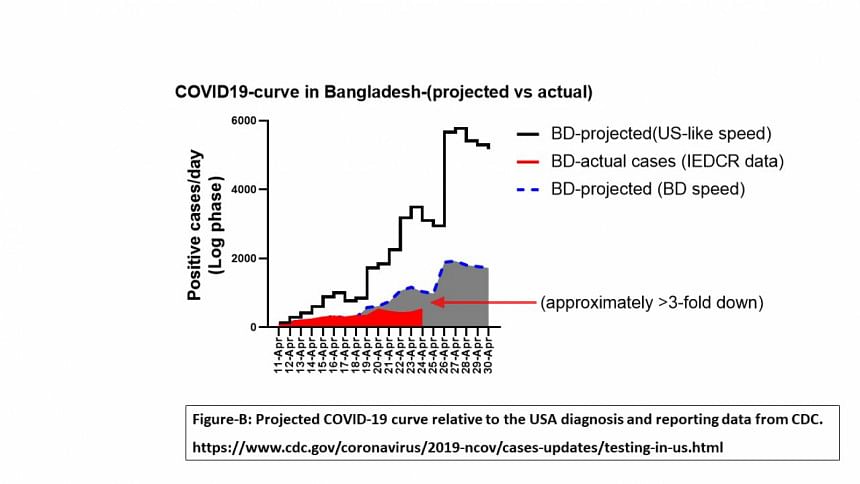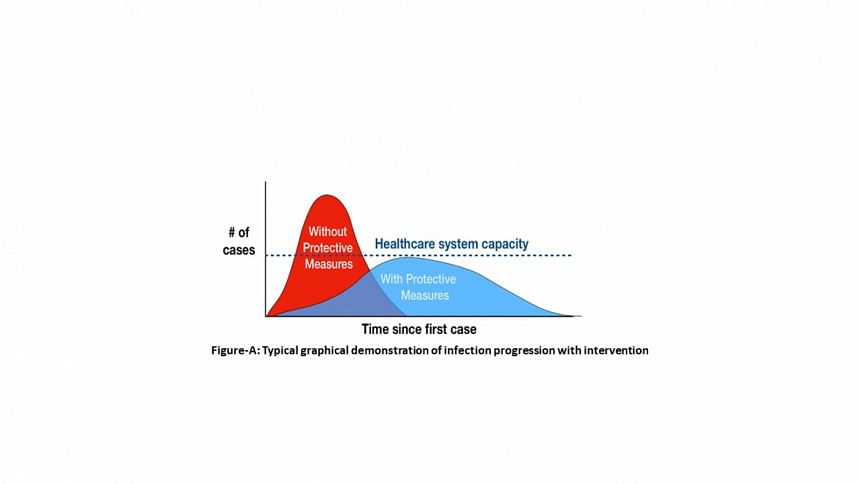Covid-19 diagnosis and the reporting curve in Bangladesh

Bangladesh is now one of the many countries to have been hit by the Covid-19 wave that has swept across the world. At this point, it is extremely important to follow "stay at home" orders without a second thought. From the epidemiological point of view, any deviation from this will likely result in the formation of Covid-19 hotspots, which means clusters of infection in places around the country. We have already seen such epicentres in Dhaka and Narayanganj, and other countries' experiences show that epicentres are very typical before Covid-19 cases escalate exponentially. Diagnosis of Covid-19 active cases (symptomatic) and their contacts (asymptomatic), and isolation of those individuals to limit further spread, are key measures in this scenario.
In contrast to other countries, Bangladesh had plenty of time to stem the spread of coronavirus since the first Covid-19 case was detected. Except telling people to stay at home, there was not enough planning on how to speed up diagnosis and the best way to handle reported cases in terms of the current stay at home order. On top of the uncertainty and lack of directions, we have already seen many break the rules of social distancing around the country. This will obviously augment more hotspot formation and finally lead to an uncontrollable situation. The Covid-19 outbreak in each country is an unprecedented situation and it was expected that experts in the country would provide guidance ahead of time.
From day one, The Institute of Epidemiology, Disease Control and Research (IEDCR) was in the driver's seat and giving the necessary directions, but there was slow diagnosis and a lack of clear information; and fear and anxiety among healthcare professionals only added to these problems. Although Bangladesh recently increased the number of testing laboratories around the country, it is beyond their capacity to catch up with patients awaiting to get diagnosed. And without testing of all possible symptomatic patients, the Covid-19 curve that visualises the progression of the virus will be not be very useful in taking decisions on the measures required to control the pandemic.
Rapid diagnosis is critical because Covid-19 has a clear incubation time within human hosts— 7-14 days—after which you either show symptoms of infection or remain healthy. This incubation time could vary between individuals because everyone is not social distancing perfectly, so it could take longer than 14 days to detect. Nevertheless, under this situation, once we know the true number of cases in the country, we could see the cases "peak" over the next couple of weeks. If we strictly maintain social distancing, the number of new cases everyday could begin to drop.

In any disease outbreak, we need to identify the associated factors and possible interventions in order to limit the spread. Therefore, epidemiological modelling serves as an essential tool to understand the outbreak of a disease, which critically helps experts to plan accordingly. In this case, almost all affected countries carefully followed the kinetics of Covid-19 progression and proposed social distancing and self-isolation, since the virus is highly contagious. The idea was to limit transmission and reduce its severity. A typical model (Figure A) shows the escalation of cases when there is no intervention in place. However, with interventions, numbers of cases drop significantly and the curve starts to flatten. This is a fundamental understanding that needs immediate attention. To this end, diagnosis of Covid-19 is critical for two reasons—doctors will take extra precautions in treating patients without exposing themselves to the virus, and the number of positive cases will be added to the Covid-19 curve to follow its progress and keep those cases isolated. Unfortunately, in Bangladesh, the only intervention strategy to date against Covid-19 has been to keep people isolated. Social distancing for 165 million people in such a small country is a huge challenge and of course, this requires cooperation from the public too.
Based on the number of cases in Bangladesh per day since the outbreak started, we can analyse the trajectory of its Covid-19 curve. Using the US as a reference in diagnosis and reporting as a whole, the projected curve (Figure B) for Bangladesh is modelled by the population and if the diagnosis rate is followed like in USA. The actual progress is shown based on IEDCR's diagnosis and reporting every da. If the current speed of diagnosis continues, Bangladesh is approximately three fold behind in reporting numbers of positive cases due to slow diagnosis. This clearly shows how the Covid-19 curve will be misleading for Bangladesh and there will be neither a peak nor a flattening of the curve to look for in the coming weeks. Therefore, Bangladesh will not see the expected results of the "stay at home" interventions. This information is really important for public health professionals and policymakers to make key decisions—when social distancing measures should be put in place, how to best utilise resources within a health system, and how to reduce Covid-19's impact on communities. This Covid-19 curve could also provide hints on what could happen in the next weeks or months, and whether preventive measures are working. However, Covid-19 modelling in Bangladesh is based on low rates of diagnosis due to a lack of available kits and diagnostic centres, which means the data that it is modelled on could be misleading.
There are a number of ways to increase testing and show more accurate rates of diagnosis. In the US, many private companies or universities were asked to help in diagnosis using their own resources. The Bangladesh government needs to coordinate with several key organisations to provide volunteers for this work as well. The Graduate Biochemists Association and Microbiologists Association in Bangladesh are some key points of contact. These organisations can help in providing trained graduates who can run the PCR-diagnosis as soon as they are placed in diagnostic centres. Universities could also use their own resources in campuses to accommodate more tests by trained students. Similarly, private diagnostics labs around the country should be given the opportunity to run samples as well. IEDCR can then compile all the data, and analyse and report from different angles.
Given that Bangladesh is running far behind in terms of speedy diagnosis, IEDCR should analyse the data by plotting it according to districts, as long as people stay at home. Over the next few weeks, the Covid-19 curve will show whether the number of cases are dropping or not, especially in places where hotspots are clearly seen. This will also identify whether any new hotspots are being generated. Once these phases are critically monitored, fear among patients, regardless of Covid-19 infections, will be reduced, and doctors will be able to provide necessary support.
Dr Jubayer Rahman is a PhD in Infectious Immunology from Maryland, USA.

 For all latest news, follow The Daily Star's Google News channel.
For all latest news, follow The Daily Star's Google News channel. 



Comments